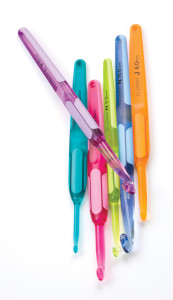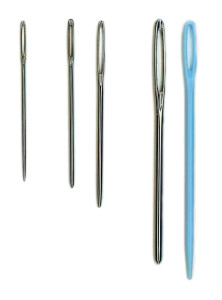Crocheters are usually pretty conscientious when it comes to taking care of their crochet materials, such as yarns, threads, books and magazines, but often don’t give much thought to their crochet tools. Here is some helpful information about caring for your crochet tools– hooks and needles, as well as some suggestions for which tools to use.
Crochet Tools |Aluminum vs. Plastic Hooks
Aluminum and plastic hooks are by far the most economical options in crochet hooks, but which is really the better purchase?

AluminumHooks

PlasticHooks
Aluminum hooks are strong, lightweight and smooth. They don’t bend or snag the yarn. Plastic hooks are often brittle, and the surface of the hook isn’t as smooth as aluminum. Plastic hooks can bend and even break and easily become pitted, which can cause snags that slow you down, resulting in nonuniform stitches. The jumbo plastic hooks are the exception to the rule—they are made differently, are excellent for large or bulky projects, and their design is satisfactory to their purpose.
Aluminum hooks can also become pitted over time from being dropped or stored carelessly. A snag on the hook will cause your yarn to pull and separate as you crochet. If your hook begins to snag your yarn, but you can’t see or feel any surface damage on your aluminum hook, try passing a piece of nylon stocking or another silky fabric over the hook; the slightest imperfection will snag the fabric.
Never try to correct the problem by sanding the aluminum hook. Discard it and get a new one.
Overall, even though they cost a little more, aluminum hooks are the better choice. You’ll find that in the long run, they are by far the most economical choice between the two. Being thrifty is wonderful, but most times, you get what you pay for. Always try to use the finest materials and tools your crafting budget will allow.
Caring for Your Crochet Tools
A great way to clean steel crochet hooks is to soak them in rubbing alcohol from time to time and dry them with a soft cloth. They’ll sparkle and give you a smoother stitching experience.
Beeswax, available at sewing-notion counters nationwide, is a great tool for keeping your hooks stitching smoothly. Try buffing your newly cleaned crochet hooks with beeswax, and they’ll zip through your crochet work!
Treat your wooden hooks as you would any fine furniture: Don’t use water! Clean them with wood oil and buff them with beeswax to keep the wood well-protected. Over time, wooden hooks will take on a satiny patina if they are cared for properly. This also will improve their performance and preserve them.
Due to the nature of a wooden hook, if it’s not made correctly or cared for properly, a wooden hook will sometimes split or snag your yarn. In this case, sand the hook carefully with superfine sandpaper, steel wool or the fine side of an emery board until it is smooth. Then, apply a coat of paste 74 Everything Crochet wax and polish, or you might apply one or two coats of clear varnish, sanding lightly between coats.
Care for bone hooks as you would plastic hooks, but never soak them in a soapy solution. Just clean them gently with a wet cloth, dry them thoroughly and then give them a good buffing with beeswax to keep them from drying out.
Keeping your crochet hooks cleaned and preserved is important, and so is storing them safely. Never throw your unprotected hooks in with the rest of your supplies. Keep hooks protected in a case made specifically for this purpose, or wrap them in felt.
TAPESTRY NEEDLE VS. YARN NEEDLE
Some pattern instructions call for a tapestry needle and some call for a yarn needle or even an embroidery needle. Each needle serves a specific purpose and is shaped to best do its job.

Left to right: embroidery needle, tapestry needles (second and third) and yarn needles (fourth and fifth)
An embroidery needle has a sharp point designed for finer needlework and is not suggested for projects crocheted with yarn as it tends to split the yarn plies. A tapestry needle, with a point that is slightly less sharp, is used for tapestries, larger embroidery designs, finishing garments and some crocheted items. It has a large enough eye to accommodate fine and lightweight yarns.
Yarn needles, either plastic or steel, are a bit more blunted on the end, usually have a larger eye than tapestry needles and are perfect for conveying medium and bulky weight yarns. Yarn needles glide right through the stitches for perfect alignment and ease in working. Using a yarn needle ensures the best results for your heavier crochet projects.
When not in use, it’s best to keep needles in an appropriate storage case. While it might be tempting to stick your yarn or tapestry needle into a piece of furniture while working on a project, this can ultimately dull the tips of steel needles and might break plastic needles.




3 Responses to Caring for Your Crochet Tools